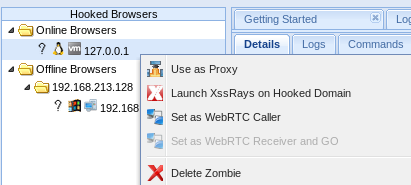Tunneling is the process of encapsulating a payload protocol inside a delivery protocol, such as IP. Using tunneling, you can transmit incompatible protocols across a network, or you can bypass firewalls that are configured to block a particular protocol. BeEF can be configured to act as a tunneling proxy that mimics a reverse HTTP proxy—the browser session becomes the tunnel and the hooked browser is the exit point. This configuration is extremely useful when an internal network has been compromised, because the tunneling proxy can be used to do the following:
- Browse authenticated sites in the security context (client-side SSL certificates, authentication cookies, NTLM hashes, and so on) of the victim's browser
- Spider the hooked domain using the security context of the victim's browser
- Facilitate the use of tools such as SQL injection
To use the tunneling proxy, select the hooked browser that you wish to target and right-click on its IP address. In the pop-up box, as shown in the following screenshot, select the Use as Proxy option:

Configure a browser to use the BeEF tunneling proxy as an HTTP proxy. By default, the address of the proxy is 127.0.0.1 and the port is 6789.
If you visit a targeted website using the browser configured as the HTTP proxy, all raw request/response pairs will be stored in the BeEF database, which can be analyzed by navigating to Rider | History. An excerpt of the log is shown in the following screenshot:

Once an attack has been completed, there are some mechanisms to ensure that a persistent connection is retained, including the following:
- Confirm close: This is a module that presents the victim with a Confirm Navigation - are you sure you want to leave this page popup when they try to close a tab. If the user elects to Leave this Page, it will not be effective, and the Confirm Navigation popup will continue to present itself.
- Pop-under module: This is configured to autorun in config.yaml. This module attempts to open a small pop-under window to keep the browser hooked if the victim closes the main browser tab. This may be blocked by pop-up blockers.
- iFrame keylogger: This facilitates rewrites of all of the links on a web page to an iframe overlay that is 100 percent of the height and width of the original. For maximum effectiveness, it should be attached to a JavaScript keylogger. Ideally, you would load the login page of the hooked domain.
- Man-in-the-browser: This module ensures that whenever the victim clicks on any link, the next page will be hooked as well. The only way to avoid this behavior is to type a new address in the address bar.
Finally, although BeEF provides an excellent series of modules to perform the reconnaissance, as well as the exploit and post exploit phases of the kill chain, the known default activities of BeEF (/hook.js and server headers) are being used to detect attacks, reducing its effectiveness. Testers will have to obfuscate their attacks using techniques such as Base64 encoding, whitespace encoding, randomizing variables, and removing comments to ensure full effectiveness in the future.
